How to create a QR code for app store or play store app?
Creating a dedicated download QR code for your app with DeepQR is straightforward and can be done in just four simple steps:
- Register and log in to the DeepQR website.
- Add the App component and input the download links from the app stores.
- Preview and generate the QR code.
- Download the QR code.
Preparation
Before creating your QR code, it’s crucial to gather some basic information to ensure the QR code directs users correctly to download your app.
Identify the Target Platforms (iOS, Android, or Both)
Using DeepQR, you can create a download QR code that supports multiple platforms. For instance, iPhone users will be directed to the App Store, while Android users will be directed to the Google Play Store. You can also generate a QR code for a single platform if needed.
Obtain Your App’s Download Links
Before using DeepQR’s QR code generator, you need to get your app’s download links from the App Store and Play Store. Here’s how to get these links:
How to Get the App Store Link
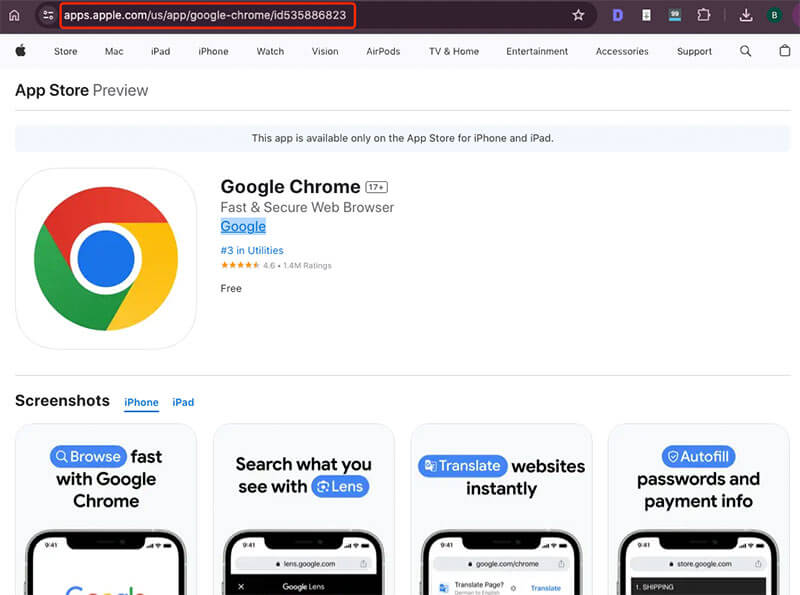
- Open the App Store: Open the App Store on your iOS device.
- Search for Your App: Type the name of your app in the search bar and search.
- Select Your App: Find and select your app from the search results.
- Copy the Link:
- Tap the "Share" button in the top right corner.
- Select "Copy Link" from the sharing options.
- You now have the download link for your app on the App Store.
How to Get the Play Store Link
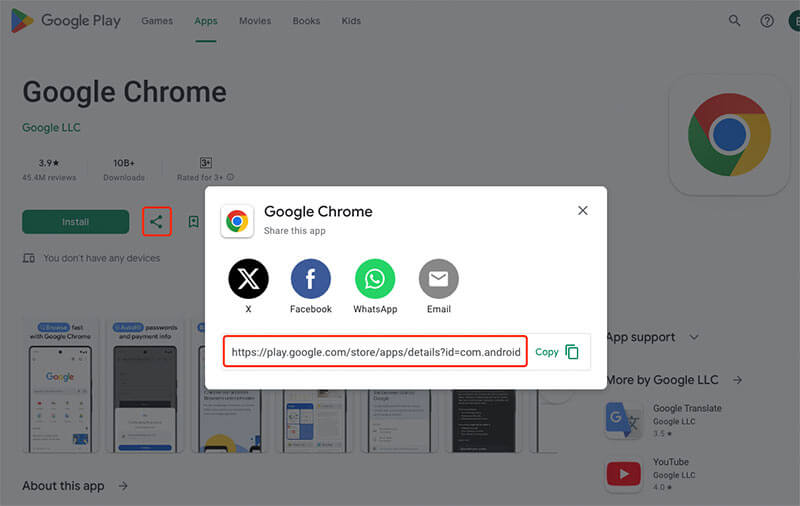
- Open the Play Store: Open the Google Play Store on your Android device.
- Search for Your App: Type the name of your app in the search bar and search.
- Select Your App: Find and select your app from the search results.
- Copy the Link:
- Tap the "Share" button in the top right corner.
- Select "Copy Link" from the sharing options.
- You now have the download link for your app on the Play Store.
Creating the QR Code
Log into Your DeepQR Account
Open the DeepQR website (deepqr.com) in your browser. If you’re using it for the first time, click the "Dashboard" button to register. You can register using a Google account or an email address. Upon successful registration, you’ll automatically get the Freemium plan, which allows you to create up to three QR codes of any type for free.
Add the App Component
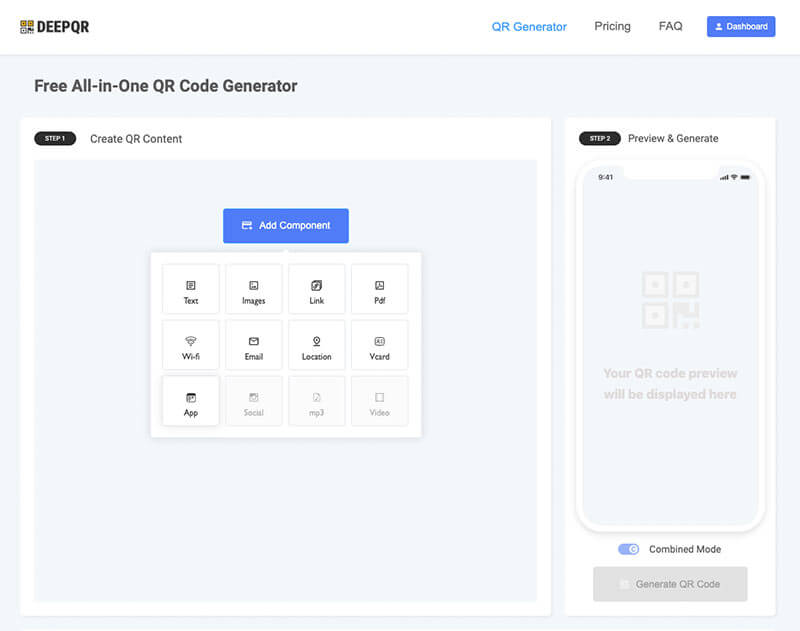
On the DeepQR homepage, click the "Add Components" button and select the "App" component. In the App component settings window, enter the download links for your app from the App Store and Play Store. Double-check the links for accuracy, then click "Save."
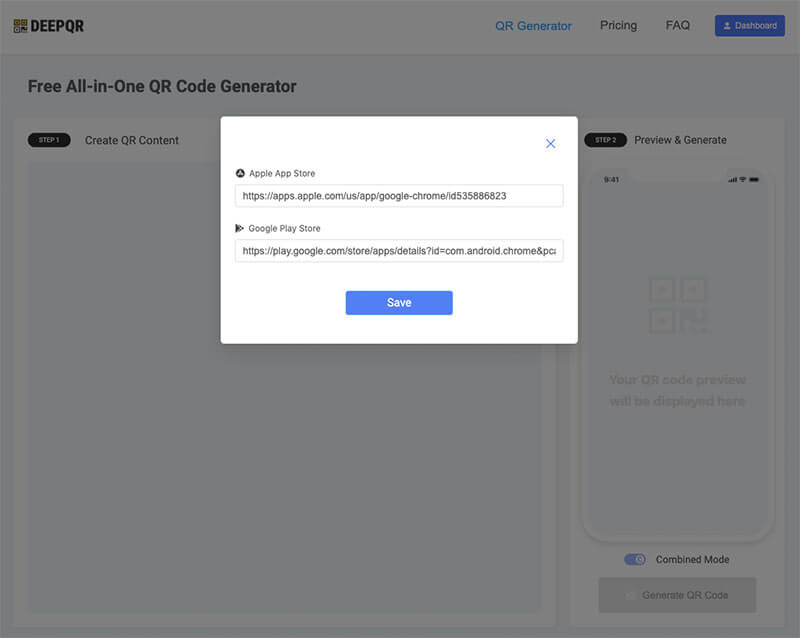
Generate the QR Code
Choose Between Solo Mode and Combined Mode
DeepQR offers two QR code display modes: SOLO and COMBINED. Here’s the difference:
Solo Mode: In Solo mode, scanning the QR code will automatically direct users to the appropriate app store download page. iPhone users will be taken to the App Store, while Android users will be taken to the Google Play Store.
Combined Mode: In Combined mode, users will see an app card after scanning the QR code. They need to tap a button to be directed to the app store. This mode is automatically enabled when multiple components are added to a single QR code.
Preview and Generate the QR Code
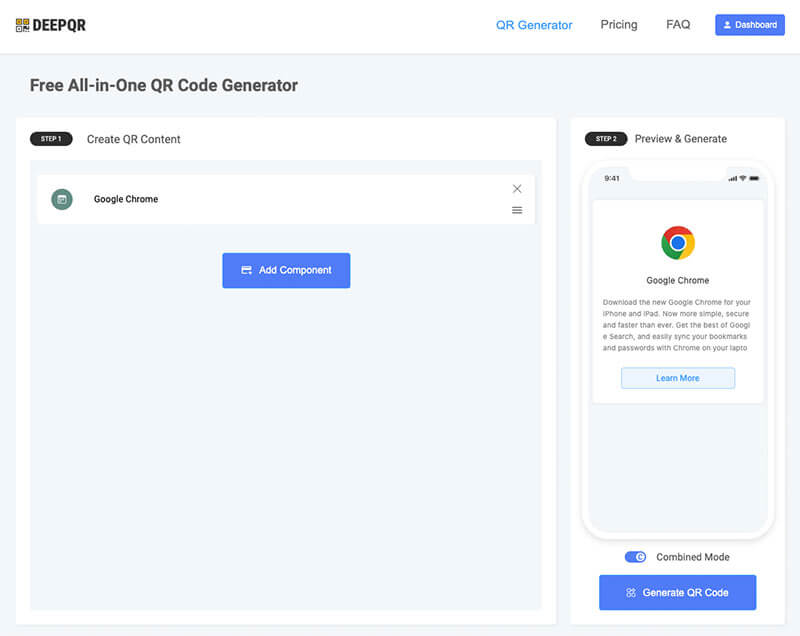
While editing the QR code, the preview area will show a real-time preview of the QR code’s scanning effect. Once satisfied with the preview, click the "Generate QR Code" button to save and generate the QR code.
Customize the QR Code Style
After generating the QR code, you can customize its style and colors, and even add a logo to the center of the QR code to better fit your usage scenario.
Testing the QR Code
After creating and customizing the QR code, it’s essential to thoroughly test it to ensure it works correctly and provides a good user experience. Here’s how to test your QR code:
Test Scanning the QR Code with Your Phone
Test with an iPhone:
- Open the Camera app on your iPhone and point it at the QR code.
- The camera will recognize the QR code, and a link will appear on the screen. Tap the link to go to the App Store download page.
Test with an Android Phone:
- Open the Camera app on your Android phone and point it at the QR code.
- If the camera app supports QR code scanning, a notification with the download link will appear. Tap the notification to check if it correctly directs to the Play Store download page.
- If the camera app doesn’t support QR code scanning, you can use a third-party QR code scanning app to test.
Check the QR Code’s Scannability
Test on Different Devices:
- Ensure the QR code works on different devices and operating systems (iOS, Android, Huawei).
Test in Different Environments:
- Test the QR code’s scannability under various lighting conditions, such as bright light, low light, and natural light.
- Print the QR code and test its scannability from the printed version to ensure it works well in practical applications.
Check the QR Code’s Clarity and Size:
- Ensure the QR code’s size is appropriate and can be easily scanned in the intended usage scenarios.
- Adjust the size if necessary, as a QR code that’s too small or too large may affect its scannability.
Publishing and Using the QR Code
Once you’ve confirmed the QR code works correctly and provides a good user experience, you can use it in various promotional and marketing activities.
Website:
- Add the QR code to your website’s homepage or download page, allowing visitors to scan and download the app directly.
- Embed the QR code in blog posts, announcements, or tutorials to increase downloads and user engagement.
Print Materials:
- Print the QR code on physical promotional materials, such as flyers, posters, or brochures, so potential users can quickly access and download your app.
- Ensure the QR code’s size is appropriate and clear, matching the design style of different printed materials.
Social Media:
- Share the QR code image and download links on social media platforms like Facebook, Twitter, and Instagram to attract more users to download your app.
- Utilize social media sharing features to make it easy for users to forward the QR code, expanding its reach.
Email:
- Include the QR code in your email marketing campaigns, encouraging recipients to scan and download the app.
- Add the QR code to your email signature or regular newsletters to increase the app’s visibility.
Important Considerations
Avoid Common QR Code Generation Errors
Incorrect Link Input:
- Ensure the download links you input are correct and complete.
- Double-check the links before generating the QR code to avoid typos or missing parts.
QR Code Size:
- Ensure the QR code is appropriately sized. A QR code that’s too small may be difficult to scan.
- The recommended minimum size for a QR code is 2x2 centimeters to ensure most devices can easily scan it.
Updating Dynamic QR Code Information
Change Download Links:
- If the download links change, you can update the QR code information directly through the DeepQR dashboard.
- DeepQR allows you to update the content of a QR code without changing its image, ensuring users always access the latest download link.
Update QR Code Content:
- Regularly check and update the QR code content to maintain its accuracy and relevance.
- Adjust and update the QR code content through the dashboard if your promotional strategy or content changes.
Ensuring QR Code Usability
Print Testing:
- Test the QR code by printing it to ensure it can be clearly scanned in real-world use.
- Use high-quality printing equipment and paper to avoid issues with print quality affecting scannability.
Environment Testing:
- Test the QR code’s usability in various lighting conditions and on different devices to ensure it works well in all environments.
- Consider the different devices and applications users might use to scan the QR code to ensure it functions correctly across various scenarios.
Error Correction Setting:
- Set the error correction level (e.g., low, medium, high, ultra-high) based on your specific needs.
- An appropriate error correction level can ensure the QR code remains scannable even if it is partially damaged or obscured.
Appendix
We have compiled some common QR code generation guides, such as text QR codes, image QR codes, and more. Using different types of components can help you create powerful QR codes.
